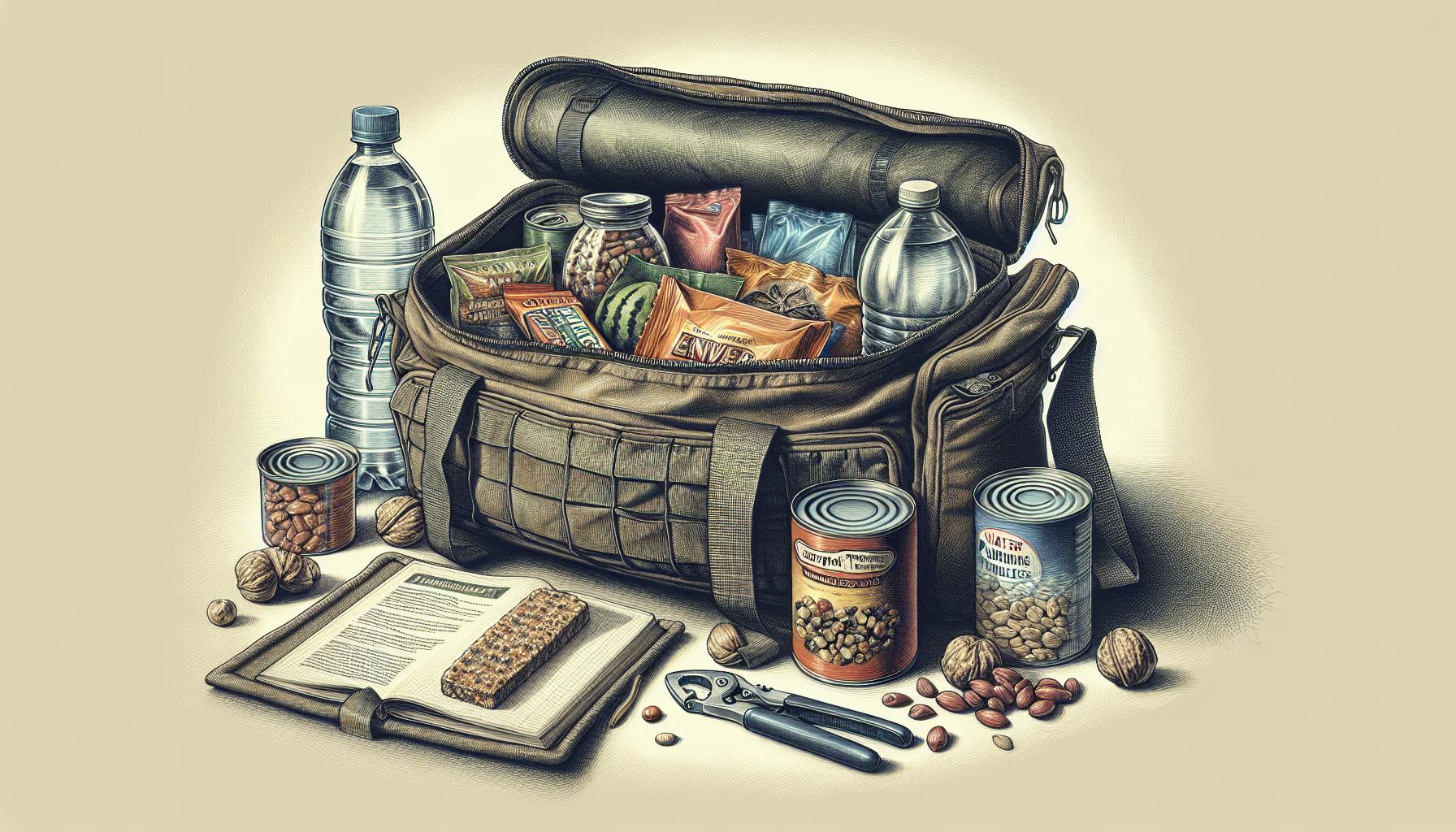Introduction to Canned Food Essentials for Doomsday Prepping
When preparing for potential disasters or doomsday scenarios, stockpiling canned foods is one of the wisest investments you can make. Canned goods have extremely long shelf lives, with meats lasting 2-5 years, fruits lasting 2-3 years, and vegetables lasting 2-4 years typically. They don't require refrigeration, making canned foods ideal for emergency food supplies. Certain canned foods also provide important nutrients that can mean the difference between survival and starvation in dire situations. For example, salmon contains beneficial omega-3 fatty acids, while beans offer plant-based protein and fiber. Canned foods are incredibly versatile as well - they can be eaten straight from the can or easily incorporated into all kinds of recipes. In this article, we'll introduce some key doomsday canned food items that every prepper should have on hand.
Canned Meats for Protein
Canned meats are a prepper's best friend when it comes to stockpiling protein. Be sure to rinse meats to reduce sodium content before eating. Here are some of the best options:
- Spam - This canned luncheon meat has an impressive shelf life of 2-5 years. Spam provides a good bang for your buck protein-wise.
- Canned tuna - A versatile staple that can be eaten from the can or used in tuna melts, salads, casseroles and more. Look for tuna packed in water for the best nutritional value.
- Canned chicken - Chicken breast or thigh meat cans can easily sub in for fresh chicken in recipes like chicken salad, soups and casseroles.
- Vienna sausages - These compact canned sausages offer an ultra convenient protein source that requires no prep or cooking.
- Canned salmon - Salmon provides heart-healthy omega-3 fatty acids and the soft, flaky texture works well in fish cakes, pasta and rice bowls.
Canned Fruits and Vegetables
Canned produce provides handy nutrients as well as variety. Fruits generally last 2-3 years, while veggies can last 2-4 years. Smart choices include:
- Pineapple and mandarin oranges - Fruits packed in their own juices provide vitamin C.
- Green beans, carrots, peas - Classic canned veggies add side dish options.
- Beets, sweet potatoes, pumpkin - Provide unique flavors and nutrients like vitamin A.
- Diced tomatoes - A versatile pantry staple that works in sauces, stews and more.
- Fruits canned in juice - More nutritious than fruits packed in sugary syrups.
Canned Beans, Soups and Meals
Ready-to-eat canned items are survival saviors. Beans can last 2-3 years, while soups and meals last around 2 years typically.
- Beans like kidney, pinto and black are high in plant-based protein and fiber. Rinse before use.
- Soup can provide comfort, calories and hydration. Look for low-sodium options.
- Stews, chili and pasta in sauce offer quick, hearty, filling meals.
- Baked beans make a protein-rich, versatile side dish.
- Canned hash mixes protein and veggies for an easy hot meal.
Essential Condiments and Shelf-Stable Dairy
Don't forget about canned dairy and flavor boosters:
- Evaporated milk substitutes well for fresh milk in recipes and lasts 1-2 years.
- Powdered milk has incredible shelf life of 10-20 years and just needs water.
- Canned coconut milk adds creaminess to Asian dishes and lasts 2-4 years.
- Olives, pickles provide welcome flavor variety and last up to 5 years.
- Hot sauce, mustard, mayo can spice up boring canned meals. Properly stored, these can last up to 2 years unopened.
Tips for Storing and Consuming Canned Foods
Properly storing your canned stockpile ensures safety and freshness:
- Store cans in a cool, dry place around 50-70°F. Don't set directly on concrete.
- Rotate stock using the FIFO (first in, first out) principle.
- Inspect cans carefully before opening. Don't consume bulging, leaking or rusty ones.
- Once opened, perishable cans should be consumed within 4 days. Refrigerate leftovers.
- Rinse fruits and vegetables to reduce sodium. Enjoy canned foods as is or get creative with spices, starches and other ingredients to make complete meals.
With the right selection of doomsday canned foods on hand, you can be confident your stockpile will provide versatile, nutritious options for both short and long-term disasters. Keep the canned goods organized, take expiration dates seriously, and incorporate the stock into your regular diet before an emergency strikes.
Top Recommended Canned Foods for Doomsday Prepping
Now let's dive into the specific types and brands of canned foods that should be stockpiled by disaster preppers. These items provide good nutritional value, have long shelf lives of at least 2 years, and offer versatility in preparation methods.
Canned Vegetables
Green beans - Nutrient-dense, pair well with many proteins. Look for low-sodium or no salt added.
Carrots - Beta carotene-rich, versatile side dish. Del Monte Stewed Carrots are a good choice.
Sweet corn - Provides fiber, vitamin C. Green Giant Niblets are a prepper favorite.
Mixed veggies - Quick one-stop meal base with potato, pea, bean, carrot variety.
Beets - Offer unique flavor and are loaded with vitamins and minerals.
Canned Fruits and Fruit Cocktails
Pineapple chunks or slices - Rich in vitamin C and manganese. Dole and Del Monte brands recommended.
Peaches - Sweet, tasty fruit that can be added to oats, yogurt, smoothies.
Pears - Softer texture and mild flavor for desserts or snacks.
Mixed fruit - Peach, pear and pineapple chunks offer variety. Del Monte makes a good one.
Applesauce - Shelf-stable substitute for fresh apples in baking, snacks.
Canned Meats and Seafood
Chicken - Versatile protein to add to casseroles, pasta, soup. Kirkland and Fody brands recommended.
Tuna - Wild Planet and Kirkland chunk light tuna provide sustainable protein.
Salmon - Look for wild-caught salmon rich in omega-3s. Crown Prince and Kirkland both good options.
Vienna sausages - Quick protein source to eat straight or add to dishes.
Ham - Provides salty smoky flavor to eggs, beans, potatoes.
Canned Beans and Legumes
Kidney beans - Nutritious addition to chili, rice bowls, dips. Eden Organic kidney beans recommended.
Black beans - Fiber-rich and work well in Tex-Mex dishes. Try Bush's black beans.
Pinto beans - Creamy, mild beans for tacos, nachos, etc. Goya low-sodium pinto beans are a good choice.
Lentils - Packed with protein, fiber, iron, potassium. Eden Organic or Simply Balanced lentils recommended.
Garbanzo beans - Great base for curries, salads, hummus.
Ready-to-Eat Meals
Soups - Look for low-sodium Progresso, Campbell's Chunky, Amy's organic soups.
Chili - Hormel and Stagg chili provide protein and veggies.
Pasta in sauce - Chef Boyardee and Campbell's pasta meals heat up easily.
Stews - Try Dinty Moore's classic beef stew with hearty vegetables.
Baked beans - B&M Vegetarian and Bush's Original bake beans offer plant-based protein.
Add a variety of the above canned foods to your emergency stockpile for nutritious, easy-to-prepare meal options during a disaster scenario.
Tips for Storing and Consuming Your Canned Stockpile
To get the most out of your canned foods when an emergency strikes, proper storage, rotation and food safety is key:
- Store cans in a cool, dry area around 50-70°F. Keep off concrete floors and away from heat and sunlight to prevent corrosion.
- Use the FIFO (first in, first out) system to rotate stock. Check expiration dates every 6 months.
- Inspect cans carefully before opening. Look for bulges, leaks and rust. Discard any suspicious cans.
- Wash the can lid before opening to prevent contamination from dirt or debris. Use a manual can opener vs. electric.
- Refrigerate opened cans within 2 hours and consume within 3-4 days. Reseal leftovers in a plastic container.
- Rinse fruits and veggies with water to remove excess sodium and preservatives.
- Jazz up canned foods with spices, hot sauce, rice, beans, pasta, cheese, etc. Get creative!
Food Safety Tips
When consuming canned goods, keep these food safety guidelines in mind:
- Never eat directly from the can. Always transfer to a plate or bowl first.
- Discard cans with significant dents, bulges or leakage - don't risk botulism.
- Clean the can lid thoroughly before opening to prevent dirt and debris contamination.
- Refrigerate opened perishable cans within 2 hours and use leftovers within 3-4 days.
Ideas to Improve Flavor
Bored with plain canned foods? Punch up the flavor with these easy tips:
- Season canned veggies with olive oil, vinegar, garlic, herbs and spices.
- Mix canned fruits into yogurt, oatmeal or cottage cheese for a balanced snack.
- Make a pilaf by combining canned beans, mixed veggies, broth and rice. Season to taste.
- Top canned chili or stew with shredded cheese, onions, avocado or sour cream.
- Create canned tuna salad with mayo, lemon juice and chopped celery or pickles.
Ways to Incorporate into Recipes
Don't let your canned goods just gather dust - use them in all kinds of dishes!
- Bake canned pumpkin into pancakes, muffins, breads, cookies and more.
- Add canned salmon, tuna or chicken to pasta bakes, soups, salads and casseroles.
- Mix canned beans into tacos, burritos, nachos, dips, salads and veggie burgers.
- Use canned fruits like pineapple in smoothies, compotes, baked goods and pancake toppings.
- Make chili by combining canned beans, corn, tomatoes and seasonings.
Storage Tips to Maximize Shelf Life
Use these tips to keep cans fresh and organized for years:
- Store in cool, dry area around 50-70°F. Avoid temperature extremes.
- Keep cans off concrete floors to prevent moisture damage. Use shelves or pallets.
- Organize by type and use FIFO rotation. Check expiration dates twice a year.
- Keep away from heat sources like appliances or direct sunlight that can accelerate spoilage.
- Separate meat, fruits, vegetables, beans, and ready meals into designated storage areas for easier inventory.
Buy in Bulk for Cost Savings
Take advantage of volume discounts on canned goods:
- Buy multi-packs of beans, tuna, soups and often-used basics.
- Watch for sales at grocery stores and stock up on discounted canned goods.
- Use coupons and loyalty card deals for additional savings.
- Shop big box stores like Costco for bulk canned food deals. Split large hauls with prepper friends.
- Check restaurant supply stores for discounted #10 commercial sized cans when possible.
With some planning and smart shopping, you can build an extensive and affordable canned food stockpile tailored to your family's needs and taste preferences.
Essential Canned Goods for Doomsday Survival
When putting together your doomsday survival stockpile, focus on nutritious and versatile canned goods with long shelf lives. The following categories should form the basis of your canned food prep:
- Canned fruits packed in juice - pineapple, peaches, pears
- Canned vegetables - green beans, corn, carrots, peas, beets
- Canned beans and legumes - black, kidney, pinto, lentils, chickpeas
- Canned meats - chicken, tuna, salmon, turkey, ham
- Ready-to-eat meals - chili, pasta, stews, soups
- Canned broths and tomato products - versatility for cooking
- Powdered milk, shelf-stable dairy - nutrients and versatility
- Condiments - olives, pickles, hot sauce, spices
Remember to prep canned goods properly - take stock rotation and expiration dates seriously, store in a cool, dry place, and incorporate into your diet before an emergency arises. Use within 4 days of opening. With the right canned food stockpile, you can be confident in your ability to feed your family nutritious, delicious meals during any doomsday disaster scenario. Stay prepped!


